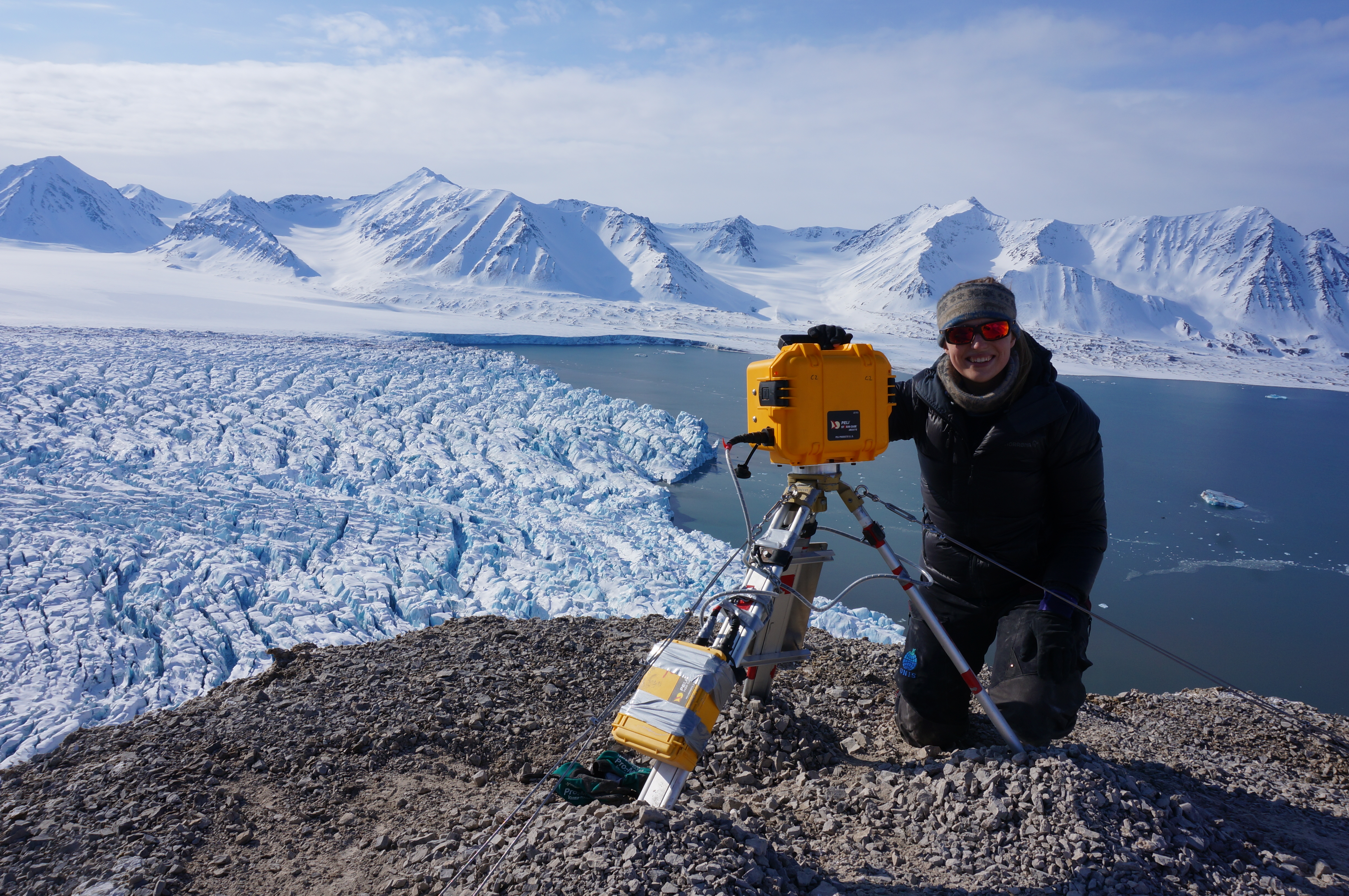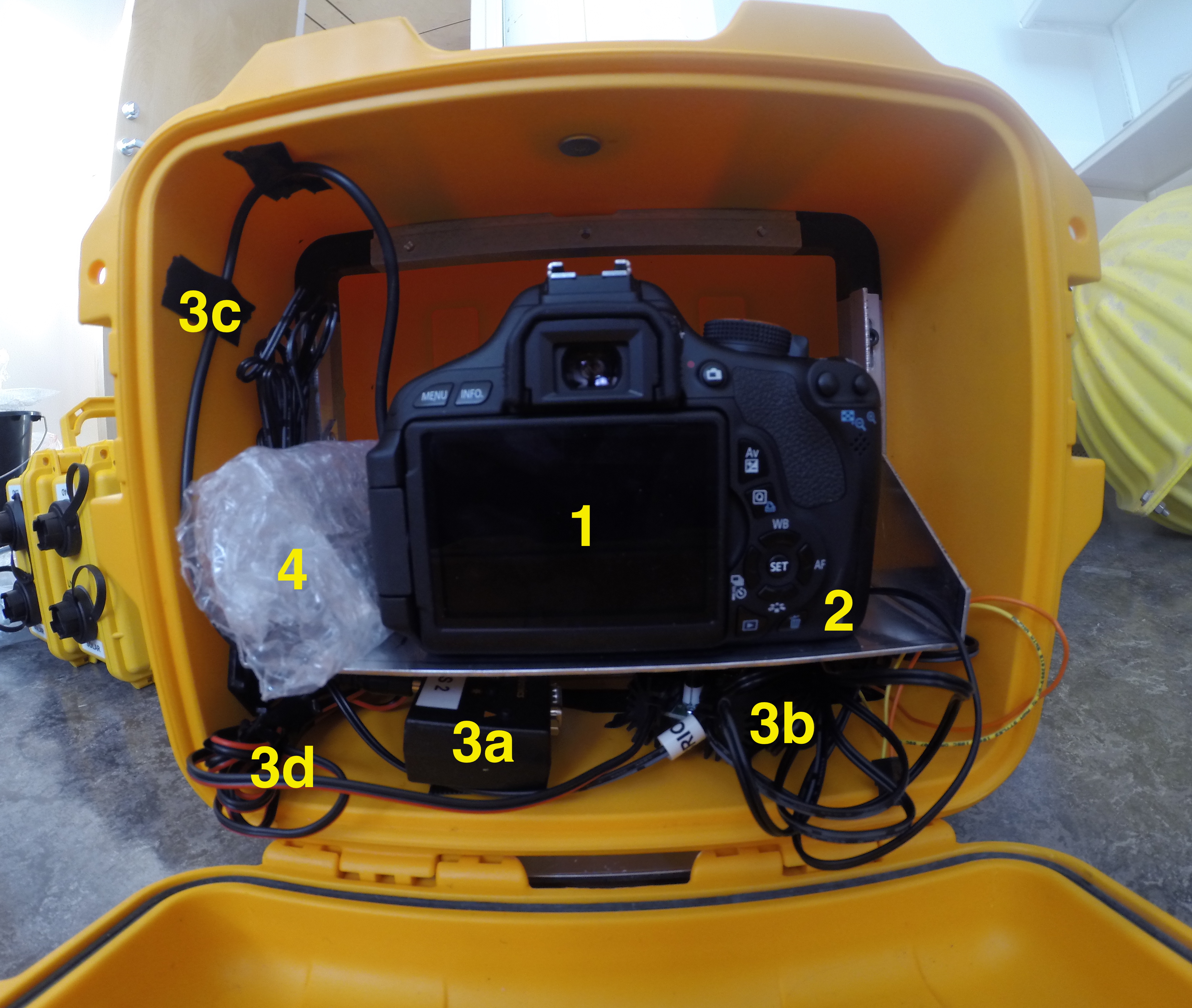Inside our cameras
Sometimes we get requests concerning what equipment we use in our time-lapse camera systems. Our systems are not off-the-shelf products, we buy specific parts and put them together ourselves to save money and ensure that the systems contain the most suited components for what we want to do. Here is a summary of the components that make up our systems.
The set-up

Me and one of our cameras overlooking the front of Kronebreen glacier in Svalbard (May 2015). Photo credit: Heïdi Sevestre.
1. The camera box
Our camera boxes are custom-made by Alex Hart and the University of Edinburgh GeoSciences workshop. The original box is a Peli iM2075 Storm Casewhich the workshop team take and modify. The modification involves:
- Cutting a porthole in the front of the box for the camera to take pictures from, with two ring plates that hold a piece of fibre optic glass (bought from UQG Optics)
- The bottom of the box is mounted with a plate and 5/8" threaded connector so it can be attached to a surveying tripod
- An adjustable shelf is mounted on the inside of the box, on which the camera sits (secured with an M5 bolt)
- Two holes are drilled into the side of the box for waterproof connectors to be fitted, which connect to the battery box and the solar panel
- An eyebrow is mounted above the porthole, sheltering it from glare and vertical snow/rain
The box allows for easy access to the system, and flexibility on the camera model and lens that is used with the adjustable shelf system.
2. The battery box
The battery box is a customised Peli 1200 Protector Case which contains a 12 V lead acid battery. This powers the camera system and is recharged by the solar panel. We generally do not keep the battery in the same box as the rest of the camera system due to the risk of it leaking and potentially damaging the rest of the system. The box is customised for a waterproof connector to be installed into the side of the box, which connects the battery box to the camera system.
3. The solar panel
The solar panel recharges the battery, keeping the system powered for the duration of the installation. We use 60 Watt crystalline solar panels (bought from Sunshine Solar), which we adapt by reinforcing the cable and adding a waterproof connector plug (see connecting cables for more). It is important to consider what the solar panel is charging when it comes to buying a solar panel.
4. The connecting cables
The connecting cables to the camera box are fitted with waterproof connectors to keep the system water tight. Plastic wrap is also used to protect the cable from the rain, the wind and peckish wildlife - Arctic foxes are notorious for chewing through the cables!
5. The tripod
We use standard surveying tripods to mount our camera box, battery box and solar panel on to. The tripod is anchored either by burying the legs with surrounding rocks and debris, or bolts which are drilled into the surrounding bedrock. How the tripod is anchored completely depends on the terrain so we often try to bring kit for both eventualities to keep as flexible as possible.
Inside the camera box

Inside one of our camera boxes (April 2014)
1. Canon 600D/700D camera with assorted EF lenses
As well as being a good camera for image quality, we also use the Canon 600D/700D because it is efficient in power consumption, consuming very little power when on and entering a sleep mode between photos. If you are buying a camera for time-lapse uses, make sure the camera can enter a sleep mode (or buy a timer that can be programmed to make the camera sleep e.g. the Harbortronics Digisnap 2100 timer). It is also a good idea to consider the size of the image sensor as this controls the quality of the image. Cameras tend to be pricey when buying them brand new, but you can save money by buying from Ebay. The Canon 600D is no longer made (hence why we have recently started buying the Canon 700D), but there are plenty of refurbished Canon 600D bodies online. Refurbished cameras are new cameras which bear a manufacturer's defect but have been restored to a fully working state. They are perfectly fine to purchase, just the seller is not allowed to advertise it as 'new' (for more information on refurbished cameras click here).
The camera lens also controls the quality of the image, as well as the angle of view. Choosing a specific lens is a trade-off between the field of view and the level of detail. A wide-angle lens (i.e. below 50 mm) is more suited when you want to cover a large area whereas telephoto lenses (i.e. above 50 mm) are ideal for acquiring a high level of detail. This is a good webpage to find out the field of view (given as an angle) which each lens and focal length provides. We use the Canon EF 20 mm, 50 mm and 85 mm fixed focal length lenses depending on exactly what we want to capture. Fixed focal length lens are generally advised over zoom lenses as they are easier to calibrate and introduce less distortion which will be beneficial down the line when extracting measurements from the images.
2. 512/256/128 GB SD memory card
The memory card is what stores the images so it is very important to pick the right one, specifically to pick the right size for what you are using it for. Generally the choice will be between a 512 GB, 256 GB or 128 GB card for longer duration (> 3 months) time-lapse installations. 128 GB cards are very cheap nowadays (roughly £30) and can store approximately 23 000 images (highest quality JPEG images on an 18 MP camera). 256 GB and 512 GB cards are significantly more expensive but may be worth it for high-frequency or long duration time-lapse sequences. These may come down in price when/if the 1 TB memory card is released.
Fun story: Last year we ran into problems with a memory card in one of our cameras at Kronebreen (a Lexar 256 GB card). After taking valuable photos of the calving front over 6 months, the card corrupted and we lost a third of images on the card (9999 images). It was absolutely devastating and meant we had a massive chunk of our data set missing. Both SanDisk and Lexar offer free recovery software when you purchase one of their memory cards. I didn't have much hope, but on a whim I tried it. The software was extremely slow but after processing for 24 hours... we recovered the missing images.
3. Harbortronics Digisnap 2100 timer
Some cameras have integrated internal timers that can be used to program the image capture frequency. The Canon 600D/700D camera does not though, and generally we want to be able to program multiple image capture frequencies for different times of the day. We use the Harbortronics Digisnap 2100 timer, which can operate in low temperatures to capture images at regular frequencies. The timer consists of four components: the timer itself (3a), the battery converter (3b), the trigger cable (3c), and the connecting cables (3d) between these components and to camera. The timer allows both simple and advanced time-lapse settings, which are programmable via computer connection and an easy interface. The battery converter converts the power source to the voltage needed to power the camera and the timer. The trigger cable is used to connect the timer box to the camera. The connecting cables have to be modified in order to connect to a replacement power adaptor which powers the camera via the battery compartment. This relatively easy to do with a bit of soldering.
The packs are handy for minimising condensation as the desiccant balls in each pack absorb and hold water vapour. This reduces the risk of water damage to the system when left out over a long period of time. The packs come as a deal with the Peli cases, but they can also be ordered separately.
Genasun solar controller (not pictured)
The solar controller regulates the power in the system, ensuring that the solar panel recharges the battery and the battery powers the rest of the system. It is not pictured as previously we used to keep the solar controller in the battery box. We changed this in 2015 so the battery boxes could accommodate larger batteries.
